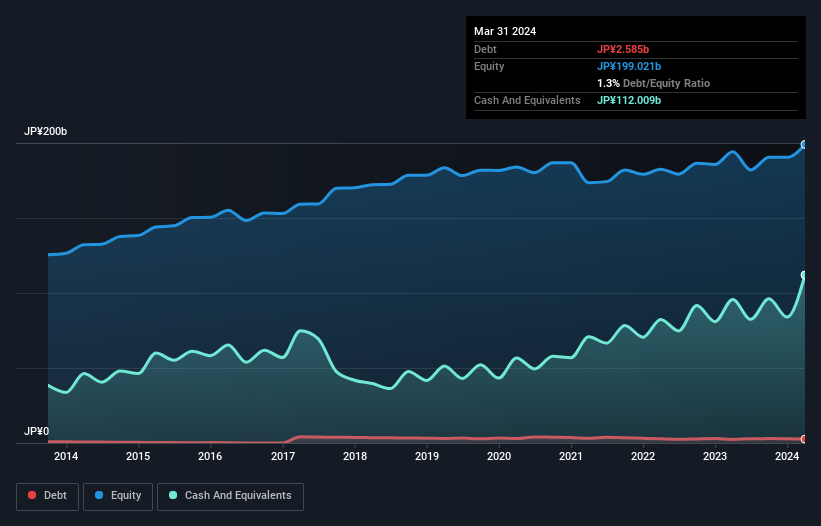
Howard Marks put it nicely when he said that, rather than worrying about share price volatility, 'The possibility of permanent loss is the risk I worry about... and every practical investor I know worries about.' It's only natural to consider a company's balance sheet when you examine how risky it is, since debt is often involved when a business collapses. We can see that USS Co., Ltd. (TSE:4732) does use debt in its business. But is this debt a concern to shareholders?
When Is Debt Dangerous?
Debt assists a business until the business has trouble paying it off, either with new capital or with free cash flow. If things get really bad, the lenders can take control of the business. While that is not too common, we often do see indebted companies permanently diluting shareholders because lenders force them to raise capital at a distressed price. By replacing dilution, though, debt can be an extremely good tool for businesses that need capital to invest in growth at high rates of return. When we think about a company's use of debt, we first look at cash and debt together.
View our latest analysis for USS
How Much Debt Does USS Carry?
As you can see below, at the end of March 2024, USS had JP¥2.59b of debt, up from JP¥2.35b a year ago. Click the image for more detail. But it also has JP¥112.0b in cash to offset that, meaning it has JP¥109.4b net cash.

A Look At USS' Liabilities
The latest balance sheet data shows that USS had liabilities of JP¥63.1b due within a year, and liabilities of JP¥9.41b falling due after that. On the other hand, it had cash of JP¥112.0b and JP¥27.1b worth of receivables due within a year. So it can boast JP¥66.6b more liquid assets than total liabilities.
This short term liquidity is a sign that USS could probably pay off its debt with ease, as its balance sheet is far from stretched. Succinctly put, USS boasts net cash, so it's fair to say it does not have a heavy debt load!
And we also note warmly that USS grew its EBIT by 12% last year, making its debt load easier to handle. There's no doubt that we learn most about debt from the balance sheet. But ultimately the future profitability of the business will decide if USS can strengthen its balance sheet over time. So if you're focused on the future you can check out this free report showing analyst profit forecasts.
Finally, a company can only pay off debt with cold hard cash, not accounting profits. USS may have net cash on the balance sheet, but it is still interesting to look at how well the business converts its earnings before interest and tax (EBIT) to free cash flow, because that will influence both its need for, and its capacity to manage debt. During the last three years, USS generated free cash flow amounting to a very robust 83% of its EBIT, more than we'd expect. That positions it well to pay down debt if desirable to do so.
Summing Up
While it is always sensible to investigate a company's debt, in this case USS has JP¥109.4b in net cash and a decent-looking balance sheet. The cherry on top was that in converted 83% of that EBIT to free cash flow, bringing in JP¥44b. So is USS's debt a risk? It doesn't seem so to us. Over time, share prices tend to follow earnings per share, so if you're interested in USS, you may well want to click here to check an interactive graph of its earnings per share history.
Of course, if you're the type of investor who prefers buying stocks without the burden of debt, then don't hesitate to discover our exclusive list of net cash growth stocks, today.
New: AI Stock Screener & Alerts
Our new AI Stock Screener scans the market every day to uncover opportunities.
• Dividend Powerhouses (3%+ Yield)
• Undervalued Small Caps with Insider Buying
• High growth Tech and AI Companies
Or build your own from over 50 metrics.
Have feedback on this article? Concerned about the content? Get in touch with us directly. Alternatively, email editorial-team (at) simplywallst.com.
This article by Simply Wall St is general in nature. We provide commentary based on historical data and analyst forecasts only using an unbiased methodology and our articles are not intended to be financial advice. It does not constitute a recommendation to buy or sell any stock, and does not take account of your objectives, or your financial situation. We aim to bring you long-term focused analysis driven by fundamental data. Note that our analysis may not factor in the latest price-sensitive company announcements or qualitative material. Simply Wall St has no position in any stocks mentioned.
Have feedback on this article? Concerned about the content? Get in touch with us directly. Alternatively, email editorial-team@simplywallst.com
About TSE:4732
Flawless balance sheet established dividend payer.
Market Insights
Community Narratives



